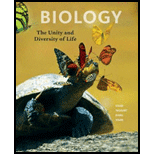
Concept explainers
Most commonly, individuals of a population show a _______ distribution within their habitat.
- a. clumped
- b. random
- c. nearly uniform
- d. none of the above
Concept introduction: A population is a group of interbreed organisms of same species that lives in same area. Population distribution is an arrangement of population in a particular area according to its conditions and requirements of the society. It also describes the location of individuals relative to one another. There are three types of population distribution, namely clumped, nearly uniform, and random.
Answer to Problem 1SQ
Correct answer: Most commonly, individuals of a population show a clumped distribution within their habitat. Hence, the correct answer is option a.
Explanation of Solution
Reason for the correct statement:
Distribution is a whole number of people or inhabitants in a specified region. Clumped distribution is an uneven distribution of population in the environment. Social interactions between the individuals can also cause the distribution to be clumped.
Option c. is given as “clumped”. In this distribution, the distance between the individuals is minimized. Therefore, the organisms do not move and the offspring are close to their parents. Hence, it shows the clumped dispersion. This limited dispersal ability increases the likelihood of a clumped distribution. Hence, option c. is the correct answer.
Reasons for the incorrect statements:
Option b. is given as “random”. Populations are randomly distributed only if the resources are uniformly available. Random distribution occurs from the nature of relationships between the individuals. Hence, option b. is incorrect.
Option c. given as “nearly uniform”. Nearly uniform distribution occurs only if there is a competition for limited resources with the individuals. Hence, option c. is incorrect.
Option d. given as “none of the above”. Most of the individuals show the clumped distribution within their habitat. Hence, option d. is incorrect.
Hence, options b., c., and d. are incorrect.
Clumped distribution of population occurs within the same habitat. The uneven distribution of resources causes the population to clump together.
Want to see more full solutions like this?
Chapter 44 Solutions
Biology: The Unity and Diversity of Life (MindTap Course List)
Additional Science Textbook Solutions
Laboratory Manual For Human Anatomy & Physiology
Chemistry: An Introduction to General, Organic, and Biological Chemistry (13th Edition)
Campbell Essential Biology (7th Edition)
Genetics: From Genes to Genomes
HUMAN ANATOMY
Organic Chemistry
- Describe two different gene regulation mechanisms involving methylationarrow_forwardWhat is behavioral adaptarrow_forward22. Which of the following mutant proteins is expected to have a dominant negative effect when over- expressed in normal cells? a. mutant PI3-kinase that lacks the SH2 domain but retains the kinase function b. mutant Grb2 protein that cannot bind to RTK c. mutant RTK that lacks the extracellular domain d. mutant PDK that has the PH domain but lost the kinase function e. all of the abovearrow_forward
- Explain how the hormones of the glands listed below travel around the body to target organs and tissues : Pituitary gland Hypothalamus Thyroid Parathyroid Adrenal Pineal Pancreas(islets of langerhans) Gonads (testes and ovaries) Placentaarrow_forwardWhat are the functions of the hormones produced in the glands listed below: Pituitary gland Hypothalamus Thyroid Parathyroid Adrenal Pineal Pancreas(islets of langerhans) Gonads (testes and ovaries) Placentaarrow_forwardDescribe the hormones produced in the glands listed below: Pituitary gland Hypothalamus Thyroid Parathyroid Adrenal Pineal Pancreas(islets of langerhans) Gonads (testes and ovaries) Placentaarrow_forward

 Biology Today and Tomorrow without Physiology (Mi...BiologyISBN:9781305117396Author:Cecie Starr, Christine Evers, Lisa StarrPublisher:Cengage Learning
Biology Today and Tomorrow without Physiology (Mi...BiologyISBN:9781305117396Author:Cecie Starr, Christine Evers, Lisa StarrPublisher:Cengage Learning Biology: The Unity and Diversity of Life (MindTap...BiologyISBN:9781305073951Author:Cecie Starr, Ralph Taggart, Christine Evers, Lisa StarrPublisher:Cengage Learning
Biology: The Unity and Diversity of Life (MindTap...BiologyISBN:9781305073951Author:Cecie Starr, Ralph Taggart, Christine Evers, Lisa StarrPublisher:Cengage Learning Biology: The Dynamic Science (MindTap Course List)BiologyISBN:9781305389892Author:Peter J. Russell, Paul E. Hertz, Beverly McMillanPublisher:Cengage Learning
Biology: The Dynamic Science (MindTap Course List)BiologyISBN:9781305389892Author:Peter J. Russell, Paul E. Hertz, Beverly McMillanPublisher:Cengage Learning Biology (MindTap Course List)BiologyISBN:9781337392938Author:Eldra Solomon, Charles Martin, Diana W. Martin, Linda R. BergPublisher:Cengage Learning
Biology (MindTap Course List)BiologyISBN:9781337392938Author:Eldra Solomon, Charles Martin, Diana W. Martin, Linda R. BergPublisher:Cengage Learning





